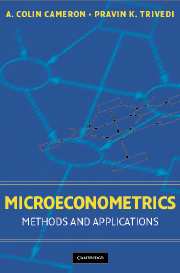 A. Colin Cameron and Pravin
K. Trivedi
A. Colin Cameron and Pravin
K. Trivedi
MICROECONOMETRICS: Methods and Applications
Cambridge University Press, New York
May 2005
PART 1 (chapters 1-3)
Part 1 covers the essential components of microeconometric analysis -- an
economic specification, a statistical model and a data set.
Chapter 1 discusses the distinctive aspects of microeconometrics, and provides
an outline of the book. It emphasizes that discreteness of data, and nonlinearity
and heterogeneity of behavioral relationships are key aspects of disaggregated
microeconometric models. It concludes by presenting the notation and conventions
used throughout the book.
Chapters 2 and 3 set the scene for the remainder of the book by introducing
the reader to key model and data concepts that shape the analyses of later
chapters.
A key distinction in econometrics is between essentially descriptive models
and data summaries at various levels of statistical sophistication and models
that go beyond associations and attempt to estimate causal parameters. The
classic definitions of causality in econometrics derive from the Cowles Commission
simultaneous equations models that draw sharp distinctions between exogenous
and endogenous variables, and between structure and reduced form parameters.
Although reduced form models are very useful for prediction, knowledge of
structural or causal parameters is essential for policy analyses. Identification
of structural parameters within the simultaneous equations framework poses
numerous conceptual and practical difficulties. An alternative approach
based on the potential outcome model, also attempts to identify causal parameters
but it does so by posing limited questions within a more manageable framework.
Chapter 2 attempts to provide an overview of the fundamental issues that
arise in these alternative frameworks. Readers who initially find this
material challenging should return to this chapter later after gaining greater
familiarity with specific models covered later in the book.
The empirical researcher’s ability to identify causal parameters depends
not only on the statistical tools and models but also on the type of data
available. An experimental framework provides a standard for establishing
causal connections. However, observational, not experimental, data form the
basis of much of econometric inference. Chapter 3 surveys the pros and cons
of three main types of data available: observational data, data from social
experiments, and those from natural experiments. The potential as well as
the difficulties of conducting causal inference based on each type of data
are reviewed.
Back to Main Page
 A. Colin Cameron and Pravin
K. Trivedi
A. Colin Cameron and Pravin
K. Trivedi